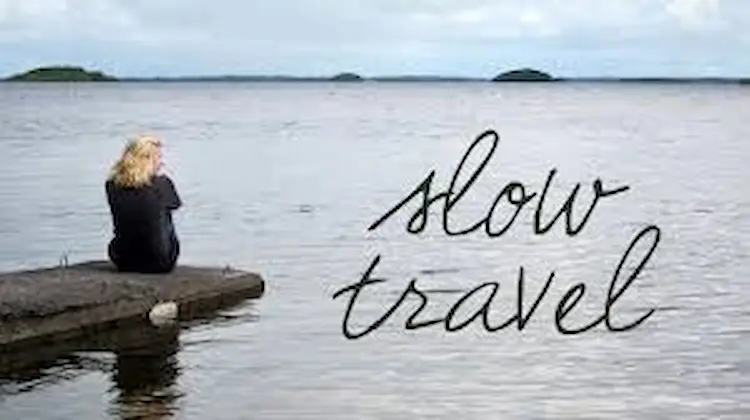In our fast-paced world, where everything moves at lightning speed, there’s a growing movement that invites us to slow down and savor the moment. Welcome to the concept of slow travel.
This blog post will explore the essence of slow travel, its benefits for the environment and personal well-being, and practical tips to help you get started on your slow travel adventures. Whether you’re a seasoned traveler or someone looking to take a more mindful approach to your trips, this guide is for you.
What is Slow Travel?
Slow travel is not just a trend; it’s a philosophy. It emphasizes the importance of immersing yourself in a destination rather than rushing through it. Unlike traditional travel, which often involves ticking off a list of tourist spots in record time, slow travel encourages you to engage deeply with your surroundings. You stay longer, explore local cultures, and truly experience the essence of the place you’re visiting.

Why Choose Slow Travel?
Environmental Benefits
One of the most compelling reasons to choose slow travel is its positive impact on the environment. Traditional travel methods, especially air travel, contribute significantly to carbon emissions. By opting for slower modes of transportation like trains, buses, or even bicycles, you can reduce your carbon footprint.
Additionally, staying in one place longer and supporting local businesses helps sustain the local economy and reduces the environmental impact of frequent travel.
Personal Well-being
Slow travel is not just good for the planet; it’s good for you too. Taking the time to relax and immerse yourself in a new environment can reduce stress and improve mental health.
You get the opportunity to disconnect from the hustle and bustle of daily life and reconnect with yourself and nature. Plus, the deeper connections you form with locals and other travelers can lead to enriching experiences and lasting memories.
How to Start Your Slow Travel Journey

Choose Your Destination Wisely
The first step in slow travel is selecting a destination that aligns with your interests and values. Look for places that offer a rich cultural experience, natural beauty, and opportunities for sustainable activities.
For example, if you’re interested in history and outdoor adventures, you might explore what to do in St. George, Utah, known for its beautiful landscapes and historical sites.
Plan Longer Stays
Instead of hopping from one city to another, plan to stay in one location for an extended period. This approach allows you to explore the area thoroughly, get to know the locals, and experience the everyday life of the destination. Longer stays also mean less frequent packing and unpacking, making your trip more relaxing.
Use Sustainable Transportation
Opt for eco-friendly modes of transportation whenever possible. Trains, buses, and bicycles are excellent alternatives to flying or driving. Not only do they reduce your carbon footprint, but they also offer unique perspectives of the landscape and opportunities for spontaneous adventures along the way.
Practical Tips for Enjoying Slow Travel
Immerse Yourself in Local Culture
One of the best parts of slow travel is the chance to fully immerse yourself in the local culture. Attend community events, visit local markets, and try traditional foods. These activities offer a deeper understanding of the destination and foster meaningful connections with the people who live there.
Engage in Local Activities
Participating in local activities is a great way to experience the essence of a place. Whether it’s hiking, cooking classes, or language lessons, engaging in these activities allows you to learn new skills and appreciate the local way of life. Plus, it supports local businesses and artisans.
Stay in Local Accommodations
Opt for locally-owned accommodations like guesthouses, bed and breakfasts, or eco-lodges. These places often provide a more authentic experience compared to large hotel chains. Staying in local accommodations also means your money goes directly to the local community, supporting sustainable tourism.
The Future of Slow Travel

The Rise of Slow Tourism
Slow travel is not just a fleeting trend; it’s a growing movement that’s reshaping the future of tourism. More travelers are seeking meaningful experiences over material possessions. This shift towards conscious travel is leading to a greater emphasis on sustainability and responsible tourism practices.
Benefits for Local Communities
Slow travel has significant benefits for local communities. By spending more time in one place, travelers contribute to the local economy and help preserve cultural heritage. Slow tourism also encourages the development of infrastructure that benefits both travelers and residents, leading to more sustainable and resilient communities.
A Mindful Approach
Adopting a slow travel mindset means being mindful of our impact on the places we visit. It encourages us to travel with intention, respect local customs and traditions, and leave a positive footprint wherever we go. This mindful approach enhances our travel experiences and fosters a sense of responsibility towards the world around us.
Conclusion
Slow travel offers a refreshing alternative to the fast-paced, checklist-driven approach to tourism. It allows us to connect deeply with our destinations, support local communities, and travel more sustainably.
Whether you’re planning your next adventure or simply looking to travel more mindfully, slow travel provides a pathway to richer, more meaningful experiences.